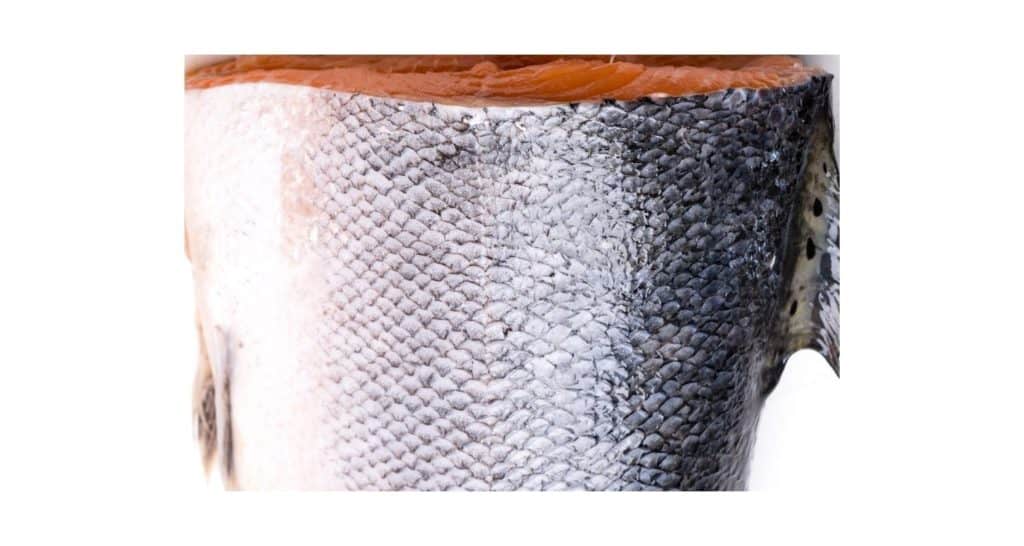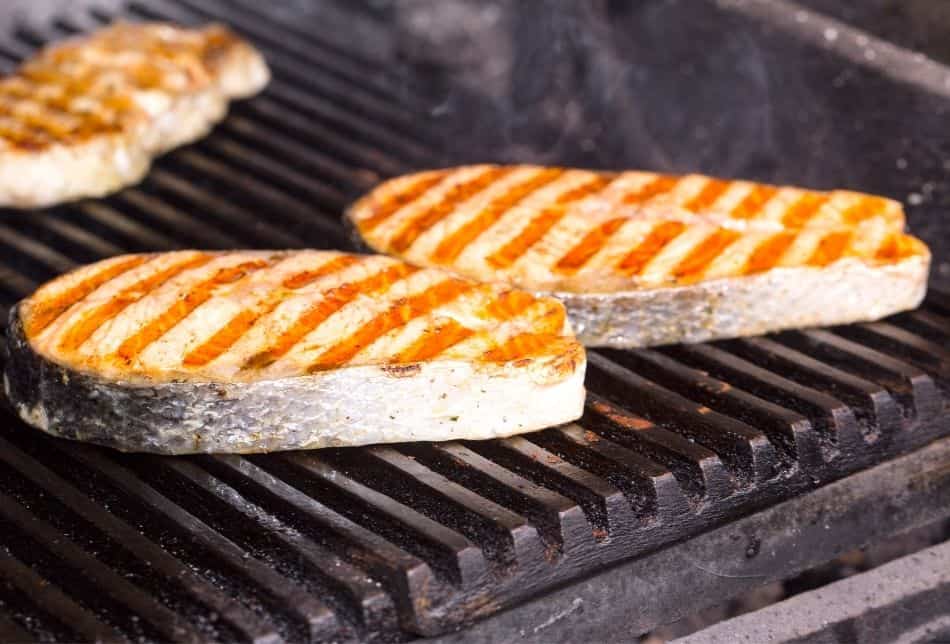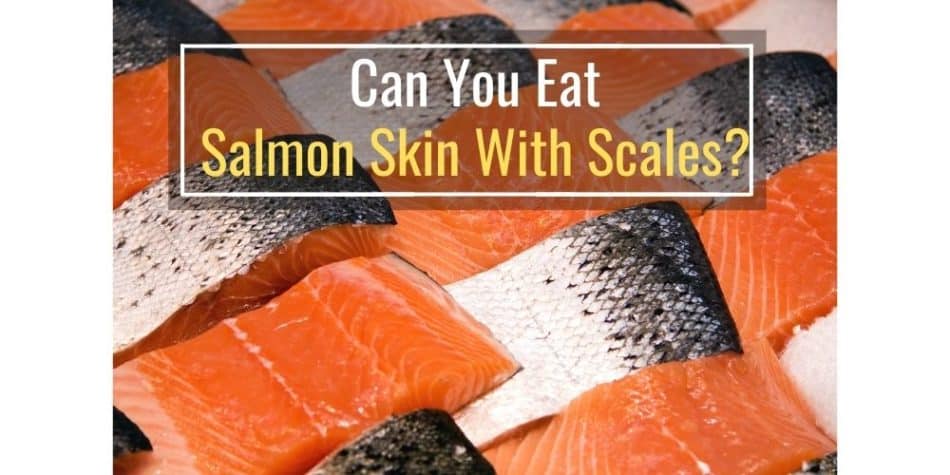Growing up, I was always told to peel a potato and carrot before cooking it. However, I have since learned that the skin of a potato and carrot hold the most nutrients so I was peeling away the nutrients of these vegetables!
I was told something similar with fish including salmon. I was told to scale the fish and either peel the skin off or fry the fish skin side down. I would only eat the meat and throw the skin away.
However, salmon skin is where most of the nutrients and omega 3 fatty acids are stored. So once again I was peeling or discarding the most nutrient part of this fish!
Knowing that I was wrong to peel and discard the skin, I started to wonder about the salmon scales themselves.
So can you eat salmon skin with scales?
Salmon skin with scales is completely safe to eat. However, larger fish scales can create an unpleasant crunchy texture when eating the skin. So removing the scales from the salmon skin comes down to personal preference and how the salmon is going to be cooked.
Leaving the scales is fine for baked or grilled salmon since the scales will help preserve the skin’s tenderness.
In fact, keeping the skin with scales can help the salmon reach medium-rare which is what most chefs and restaurants cook salmon to.
Ultimately, keeping the salmon scales on the skin comes down to personal preference and how the salmon is going to be cooked. The scales add a layer of protection when grilling salmon over a fire so you do not always want to descale salmon skin whether you decide to eat or discard the salmon skin.
However, if you do decide to descale the salmon skin then I recommend using a fish descaler since it’s a lot easier and faster than using the back of a knife. You can get fish descalers off Amazon.
Benefits of Eating Fish Scales
This might come as a surprise but there are nutritional benefits to fish scales.

One of the main components of fish scales is collagen. Collagen is a fiber protein that provides strength and flexibility to tissues and bones and plays an important role in our skin and tendons. Eating salmon skin with scales will increase the amount of collagen in the meal which is beneficial.
Fish scales are a great source of collagen. So much so that fish scales are used to produce “marine collagen.”
Marine collagen is an ingredient commonly found in collagen powders, capsules, and drinks. So save yourself some money and consume some fish scales to get your daily dose of collagen.
Although salmon skin and salmon scales have nutritional benefits, the skin can become soggy and unappetizing depending on how the fish is cooked. If the salmon is steamed or boiled then the skin can become rubbery. In this case, it may be best to discard the skin and just eat the salmon flesh.
Benefits of Eating Salmon Skin
Regardless of whether you leave the salmon scales on the skin or you descale the fish, the salmon skin can and should be eaten.
There is some debate whether farmed salmon skin should be eaten due to the living conditions of the farmed fish. I will focus on just wild salmon since many grocery stores will offer wild-caught salmon whether it’s Atlantic, Sockeye, Chinook, or Coho.
High Concentration of Omega 3 Fatty Acids
Salmon skin is nutrient-dense with most of the omega 3’s, vitamin D, and a range of other key vitamins and minerals. In fact, a study published in BMC Cancer highlighted that omega 3 fatty acids might play a role in cancer prevention.
So similar to potatoes and carrots, there are a lot of nutrients in the skin of salmon which is why the salmon skin should be consumed.
In order to avoid soggy and rubbery salmon skin, let’s quickly cover the best ways to cook salmon skin so it’s appetizing to eat.
How To Cook Salmon Skin
For those of us that do not like to eat soggy salmon skin, the best way to cook and eat salmon skin is by frying or grilling it. Frying or grilling salmon skin side down will protect the delicate flesh and also turn the skin crispy.

Depending on the cut of salmon you purchase, having salmon skin on the side of the fillet is another great option. In the image above, you can see the salmon cuts have a ring of salmon skin that holds the meat together.
The salmon skin will turn crispy when grilled which adds a nice crunchy texture to the salmon fillet.
Do not be alarmed if you see white stuff oozing out of your salmon as you cook it. Usually, the white stuff is just a protein called albumin that is safe to eat.
See this article for more information on the white stuff that sometimes comes out of salmon when you cook it.
How To Remove Salmon Scales and Keep the Skin
If the salmon scales are too large to consume or you want to remove the scales, a simple kitchen knife is all that is needed to scale salmon skin. Simply run the knife blade against the grain of the scales and the scales will begin to flake off. Once all the larger scales are removed, you can rinse the salmon skin to remove any loose scales.
Keep in mind that smaller salmon scales still hold all the nutritional benefits of the larger salmon scales but are much easy to eat and less distracting if left on the skin. So I recommend leaving the smaller scales on the salmon skin.
Not to mention trying to remove all the tiny salmon scales on the skin requires more effort than it’s worth.
How To Remove Salmon Skin and Scales
If you want to remove the skin and the scales to just leave the salmon flesh, use a sharp kitchen knife in order to cut the skin away from the meat. Another option is to cook the salmon fillet with the skin facing down and the skin can be peeled off very easily once the fish is cooked.
Here is how I remove both the salmon skin and scales quickly and easily:
- Grill the salmon with the skin side facing down on a sheet of aluminum foil
- Once the fish is done cooking, the skin will be burned to the foil
- Use a spatulat to lift the salmon off the skin and serve
The salmon skin will remain stuck to the foil which can be discarded and you’re left with perfectly tender salmon meat.
Final Thoughts
Salmon skin with scales can be eaten and the salmon skin and scales are nutrient-dense. Larger salmon scales may be unpleasant to consume so the larger scales can be removed while leaving the smaller scales. Simply bake, grill, or fry the salmon with the skin side facing down to transform the skin into a crispy delicacy.
The best advice is to just try eating a salmon fillet with scales and one without to determine if you enjoy eating salmon skin with scales.
Ultimately, it all comes down to personal preference even though you can eat salmon skin with scales.

